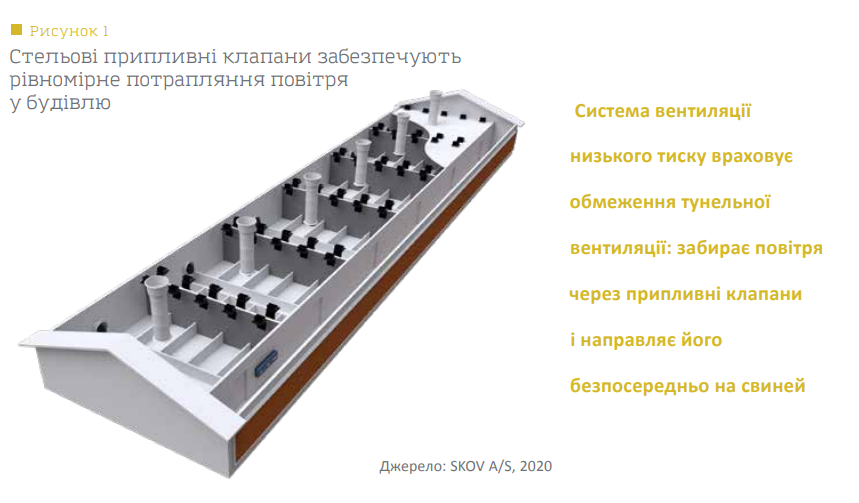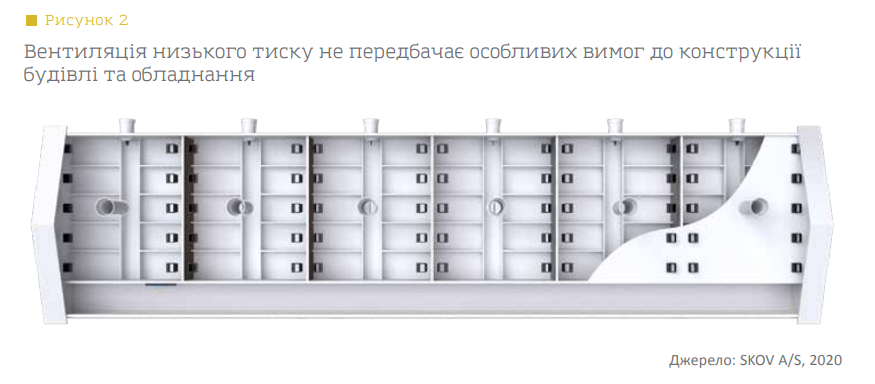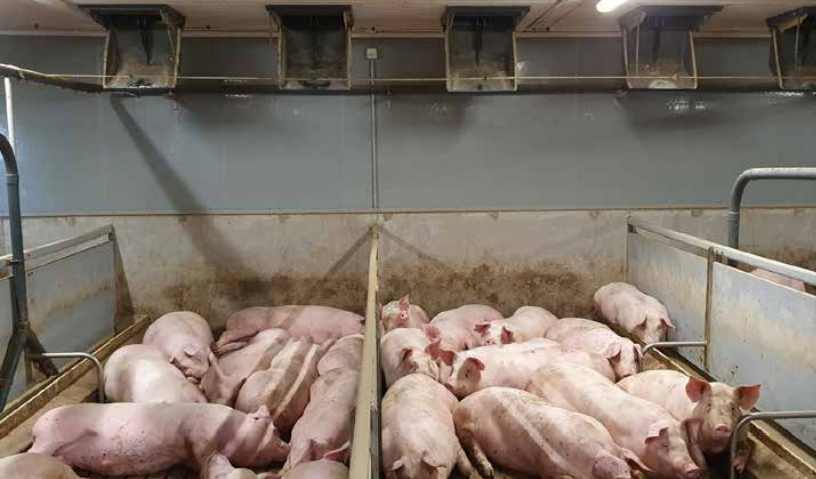Proper ventilation
During the cold season, ventilation is used to minimize the concentration of gases in the house, thus creating a healthy microclimate for the animals. The air coming in from the street is cold and therefore should not reach the pigs without preparation. Ventilation heats it up by mixing it with the warm air in the room so that its temperature and speed of movement correspond to the area occupied by the animals. The ventilation system takes away excess heat from the animals during hot periods and creates a cooling effect by circulating the air around the animals.
Tunnel ventilation — difficult to create a uniform climate
Tunnel ventilation is a method used to cool a room in the heat. Air enters the building through a cooling panel. At the other end of the building, it is sucked out by exhaust shafts. Through this circulation, a cooling effect for the pigs is achieved. However, tunnel ventilation has a number of limitations that make it difficult to provide a uniform indoor climate:
— It can be used during the hot season but not during the cold season.
— The temperature in the room usually varies, as the flow of air, moving, gradually heats up. This means that the pigs' sense of comfort and their production performance differs depending on where the machine is located.
— Tunnel ventilation requires additional farm and squad planning requirements so that «fresh» air can be evenly distributed throughout the entire pig housing area.
Low Pressure Ventilation System
The low-pressure ventilation system takes into account the limitation of tunnel ventilation: it takes in air through supply dampers and directs it directly to the pigs. Supply dampers are designed to create maximum airflow in hot weather. In cold weather, they provide air mixing before it reaches the animal housing area. Exhaust air is discharged through well-insulated shafts in the ceiling via cooling plates. An alternative in hot and dry climates is high-pressure cooling with ceiling dampers.

Ceiling air inlets provide uniform air flow into the building. The low-pressure ventilation system considers the limitations of tunnel ventilation: it takes in air through supply dampers and directs it directly to the pigs

Low-pressure ventilation does not impose special requirements on the design of the building and equipment
Correct behavior
Correct placement of ceiling flaps creates a uniform microclimate for all pigs in the house. This means that the animals properly allocate and use the resting, feeding and defecation areas as intended.
Uniform performance
The air enters the room evenly. This means that the microclimate is uniform. Consequently, the same conditions for animal growth and thus production results (Figure 1).
The low-pressure ventilation system does not impose special requirements on the buildings and equipment of livestock houses, unlike the tunnel system. Ceiling inlets are placed relative to the cohorts. As a result, the air flows directly to the animals. This means that the design of the building and equipment (e.g., squads with solid partitions) does not impede airflow (Figure 2). Previously, because of drastic temperature variations between cold and warm seasons, it was necessary to create ventilation systems with two types of air inlets. Ceiling or wall systems for cold weather and tunnel air inlets in hot weather. A low-pressure ventilation system allows you to use the same air inlet valve for both cold-weather and hot-weather intakes. This optimizes investment and reduces operating costs, including maintenance costs.
Reduced risk of spreading infections
The low-pressure ventilation system allows for protection against infections. In contrast to tunnel ventilation, which involves moving air through squads of animals in the house and thus contributes to a rapid spread of pathogens between pigs, this type of ventilation focuses air on the animals.
AgroKlimat Ukraine LLC:

2 660 Kiev, Ukraine; str. Eugene Sverstyuk, 19, office 914

+38 067 386 26 91, +38 829 52 62, +38 067 537 36 67

volodymyr.brovchenko15@gmail.com





.jpg)